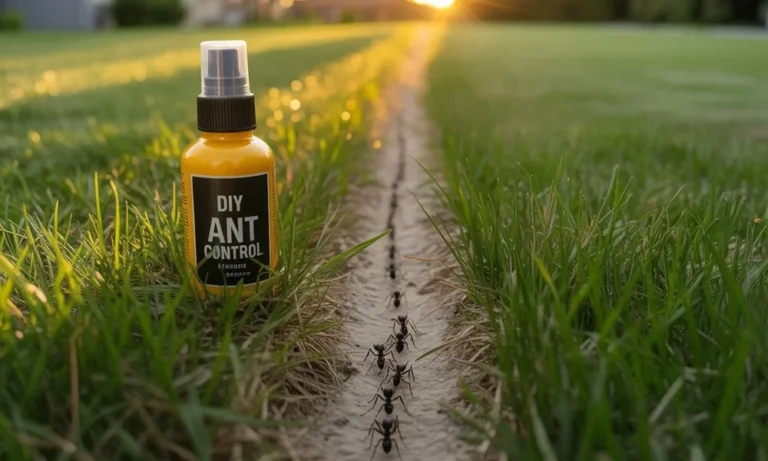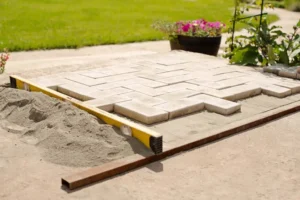How to Remove Ant Mounds from a Lawn areas is a common concern for homeowners dealing with persistent pests. Ants in grass can cause unsightly mounds, disrupt root systems, and even encourage the presence of other pests like aphids. While these tiny insects may seem harmless at first, unchecked colonies can lead to bigger problems, especially when they begin spreading throughout the yard. Killing ants in your lawn effectively, without harming the environment, pets, or children, is essential. Fortunately, there are several natural and lawn-safe solutions that can help manage infestations. Addressing ant problems early helps preserve your lawn’s health and ensures a safe, enjoyable outdoor space for your family.
Why Ants Invade Lawns

Seeing ants in my lawn or noticing small mounds of ants in grass is a common issue for many homeowners. While ants are part of a healthy ecosystem, too many can cause problems. Here’s a quick look at why ants invade lawns, their benefits and drawbacks, and common species found in turfgrass.
Why Ants Invade Yards
Ants are drawn to:
- Moisture and shelter: Lawns offer a protected, damp environment.
- Food sources: They feed on seeds, dead insects, or aphid honeydew.
- Disturbed or bare soil: Ants move in when turf is weak or patchy.
Pros and Cons of Ants in Lawns
Benefits:
- Improve soil aeration and drainage.
- Help control pests and decompose organic matter.
Drawbacks:
- Ant mounds can interfere with mowing and harm lawn.
- Some species sting or bite.
- They may protect pests like aphids.
Common Types of Ants in Turfgrass
- Field ants: Build visible mounds, often confused with fire ants.
- Fire ants: Aggressive and sting; form large mounds.
- Pavement ants: Nest near driveways, may spread into grass.
- Lawn ants (Lasius): Small mounds, common in turf areas.
While not all ants in grass are harmful, too many can damage your lawn. Identifying the type and extent of the infestation helps decide whether natural methods or pest control are needed.
Let me know if you’d like tips on how to manage ants naturally or with treatments!
You can read about How To Get Rid Of Clover In Lawn.
How to Deal with an Ant Hill
If you’ve discovered an ants nest in lawn areas, taking the right steps is key to safe and effective removal. Large mounds of ants can damage turf and become an annoyance, while tiny populations of ants can be beneficial to your yard. Here’s a step-by-step guide to kill ants in lawn areas and safely disturb or remove their nests.
Tools You’ll Need
To get started, gather the following:
- Shovel or spade
- Rake
- Boiling water (or vinegar solution)
- Garden gloves
- Bucket (optional, for water or ant bait)
- Insecticidal soap or ant killer (optional)
Step-by-Step Removal Guide
- Identify the Ant Hill
Locate the mound and note its size and number. If it’s a large ants nest in lawn, you may need repeated treatment. - Loosen the Soil
Use a shovel or rake to gently disturb the mound. This exposes the colony and begins to break up tunnels. - Apply Boiling Water
Pour boiling water directly into the hill. Ants in lawns can be eliminated naturally and chemical-free using this procedure. For added effect, use a small amount of dish soap. - Repeat if Needed
Larger nests may require several treatments. For stubborn colonies, consider using an ant-specific pesticide or bait. - Level and Reseed
Once the hill is destroyed, level the area with a rake. Add grass seed if the turf was damaged.
Best Times for Ant Hill Removal
- Early Morning or Late Evening: Ants are less active and closer to the nest.
- Spring and Early Summer: Colonies are still small and easier to manage.
- After Rain: Wet soil is easier to dig and ants are more exposed.
You can also read about How Much Is Lawn Care Per Month.
How to Get Rid of Ant Mounds in Lawn
Ant mounds in grass areas can be annoying to deal with. In addition to detracting from the aesthetics of your yard, these mounds can harm grass and make mowing more challenging. Understanding the difference between mounds and hills, how to eliminate them, and how to stop them from coming back is key.
Mounds vs. Hills: What’s the Difference?
The terms ant mounds and ant hills are often used interchangeably. Technically:
- Ant hills refer to the visible soil above a nest.
- Ant mounds can include both the soil and the underground network.
Both signal an ants nest in lawn areas that needs attention.
Effective Methods to Eliminate Mounds
- Boiling Water Treatment
Pour boiling water directly into the mound to kill ants in lawn areas naturally. Repeat as needed. - Diatomaceous Earth
Sprinkle food-grade diatomaceous earth around the mound. It dehydrates ants and is safe for pets. - Ant Baits and Pesticides
Place slow-acting ant baits near the mound. These allow worker ants to carry poison back to the colony. - Shovel and Flatten
After treatment, use a shovel to break apart the mound. Rake the area smooth and reseed if necessary.
How to Prevent Reformation of Mounds
- Keep Lawn Dry: Avoid overwatering, as ants prefer moist soil.
- Regular Lawn Maintenance: Mow and dethatch to reduce nesting areas.
- Seal Entry Points: If ants migrate toward your home, seal cracks in the foundation.
- Treat Surrounding Areas: Control nearby colonies to stop ants from relocating.
If you’re constantly spotting ant mounds in lawn spaces, it may indicate deeper soil or pest problems.
How to Get Rid of Ants in Lawn Without Killing Grass

Seeing ants in my lawn doesn’t always mean your grass is at risk, but aggressive treatment methods can harm your turf. Here’s how to kill ants in lawn areas effectively while keeping your grass healthy.
Lawn-Friendly Treatments
- Diatomaceous Earth
This natural powder damages ants’ exoskeletons without harming plants. Sprinkle around ants nest in lawn areas. - Beneficial Nematodes
These microscopic organisms attack ant larvae underground. Safe for pets, people, and grass. - Vinegar and Water Spray
Mix equal parts white vinegar and water. Spray directly into the ants nest in lawn, avoiding excess use to prevent soil acidity.
Organic & Chemical-Free Ant Control
- Cornmeal: Ants eat it but can’t digest it. Scatter lightly around the nest.
- Essential Oils: Peppermint or citrus oil mixed with water can repel ants without damaging turf.
Watering & Mowing Tips
- Water Deeply but Infrequently: Ants prefer dry, loose soil. Maintain a consistent watering schedule to deter colonies.
- Mow High: Keeping grass slightly taller shades the soil, making it less attractive for nesting.
- Avoid Over-Thatching: Excess thatch can provide shelter for ants. Dethatch in spring or fall if needed.
Choosing Lawn-Safe Commercial Products
- Look for labels that say “lawn-safe”, “pet-safe”, or “natural ingredients.”
- Avoid products with harsh chemicals like bifenthrin or permethrin unless absolutely necessary.
- Spot-treat only the affected areas to protect the surrounding grass.
You don’t have to sacrifice a healthy lawn to kill ants in lawn spaces. With the right natural methods and a bit of patience, you can control ants nest in lawn areas while preserving your turf.
Getting Rid of Ants Without Killing Them
If you’re seeing ants in my lawn but prefer a humane approach, there are several ways to manage them without causing harm. These methods focus on deterring ants or relocating them rather than destroying the colony.
Ethical Approaches & Natural Deterrents
Rather than trying to kill ants in lawn areas, you can make your yard less inviting by:
- Removing food sources: Keep the lawn clear of crumbs, pet food, and sugary residues.
- Using non-lethal barriers: Draw chalk lines or sprinkle cinnamon to discourage movement.
Relocation Methods
- Pot and Shovel Method: Place an empty flower pot over the ants nest in lawn with a bit of food inside. Once the colony begins to move in, relocate the pot to a wooded area far from your home.
- Dig and Relocate: Carefully dig around the nest and transfer soil and ants to a safe spot in nature.
Essential Oils and Scents Ants Dislike
Certain strong scents disrupt ants’ pheromone trails and make them leave voluntarily:
- Peppermint oil
- Lemon or citrus oil
- Eucalyptus
- Clove oil
Mix with water and spray around ant trails or directly onto entry points and nests.
Making Your Lawn Less Hospitable
To gently encourage ants to move on:
- Water more deeply and regularly (ants prefer dry soil).
- Mow high and keep soil healthy to disturb their ideal habitat.
- Limit mulch and lawn debris which can shelter colonies.
Using non-lethal methods allows you to manage ants in grass or ants nest in lawn areas while respecting nature. These solutions take more time but offer a compassionate way to handle an unwanted ant presence.
When to Call a Professional
If ants in my lawn are spreading rapidly, forming large ants nest in lawn areas, or reappearing after repeated treatments, it may be time to call in the pros. Signs include multiple mounds, stinging ants (like fire ants), or damage to grass and garden beds. DIY methods are great for small problems, but persistent infestations need expert solutions. Lakota Design Group offers safe, lawn-friendly ant control tailored to your yard’s needs. Call us today for a free consultation and reclaim your lawn—naturally and effectively.
FAQs
What Causes Ants To Build Nests In My Lawn?
Ants are attracted to lawns that offer dry, loose soil, shelter, and access to food sources like dead insects or sugary residue from aphids. Overly dry or compacted lawns, infrequent mowing, or the presence of mulch and thatch can also create ideal conditions for nesting.
Will Getting Rid Of Ants Harm My Grass?
Not necessarily. Many natural and lawn-safe methods—like diatomaceous earth, essential oils, and beneficial nematodes—can eliminate ants without damaging your turf. Avoid harsh chemicals or overuse of treatments that might harm grass roots or soil health.
What Is The Fastest Way To Kill Ants In My Lawn?
Pouring boiling water directly into ant mounds is one of the quickest natural methods, but it may harm nearby grass. For fast but lawn-safe control, consider ant baits that allow worker ants to carry poison back to the nest, or consult a professional for targeted treatments.
Are There Any Pet-Safe Ways To Get Rid Of Ants In Lawn Areas?
Yes. Diatomaceous earth (food-grade), vinegar sprays, and essential oil mixtures (like peppermint or citrus oil with water) are non-toxic to pets when used correctly. Always keep pets away from freshly treated areas until dry to be safe.





